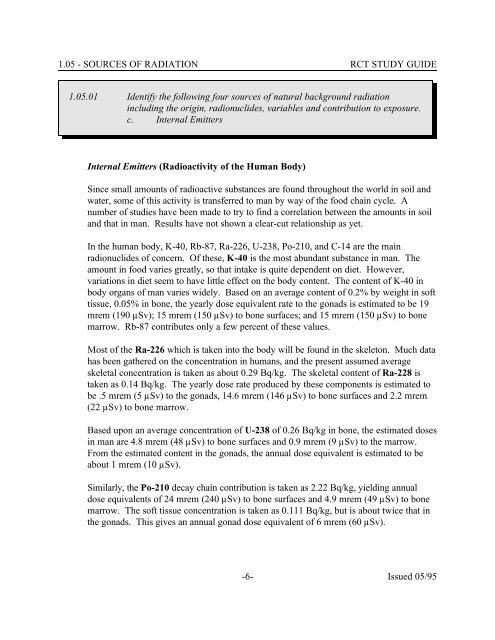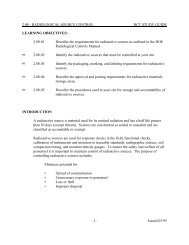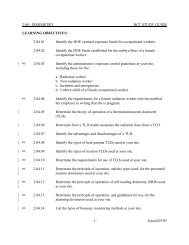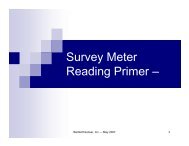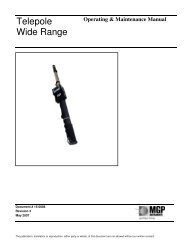SOURCES OF RADIATION - RCT STUDY GUIDE - NukeWorker.com
SOURCES OF RADIATION - RCT STUDY GUIDE - NukeWorker.com
SOURCES OF RADIATION - RCT STUDY GUIDE - NukeWorker.com
Create successful ePaper yourself
Turn your PDF publications into a flip-book with our unique Google optimized e-Paper software.
1.05 - <strong>SOURCES</strong> <strong>OF</strong> <strong>RADIATION</strong> <strong>RCT</strong> <strong>STUDY</strong> <strong>GUIDE</strong>1.05.01 Identify the following four sources of natural background radiationincluding the origin, radionuclides, variables and contribution to exposure.c. Internal EmittersInternal Emitters (Radioactivity of the Human Body)Since small amounts of radioactive substances are found throughout the world in soil andwater, some of this activity is transferred to man by way of the food chain cycle. Anumber of studies have been made to try to find a correlation between the amounts in soiland that in man. Results have not shown a clear-cut relationship as yet.In the human body, K-40, Rb-87, Ra-226, U-238, Po-210, and C-14 are the mainradionuclides of concern. Of these, K-40 is the most abundant substance in man. Theamount in food varies greatly, so that intake is quite dependent on diet. However,variations in diet seem to have little effect on the body content. The content of K-40 inbody organs of man varies widely. Based on an average content of 0.2% by weight in softtissue, 0.05% in bone, the yearly dose equivalent rate to the gonads is estimated to be 19mrem (190 µSv); 15 mrem (150 µSv) to bone surfaces; and 15 mrem (150 µSv) to bonemarrow. Rb-87 contributes only a few percent of these values.Most of the Ra-226 which is taken into the body will be found in the skeleton. Much datahas been gathered on the concentration in humans, and the present assumed averageskeletal concentration is taken as about 0.29 Bq/kg. The skeletal content of Ra-228 istaken as 0.14 Bq/kg. The yearly dose rate produced by these <strong>com</strong>ponents is estimated tobe .5 mrem (5 µSv) to the gonads, 14.6 mrem (146 µSv) to bone surfaces and 2.2 mrem(22 µSv) to bone marrow.Based upon an average concentration of U-238 of 0.26 Bq/kg in bone, the estimated dosesin man are 4.8 mrem (48 µSv) to bone surfaces and 0.9 mrem (9 µSv) to the marrow.From the estimated content in the gonads, the annual dose equivalent is estimated to beabout 1 mrem (10 µSv).Similarly, the Po-210 decay chain contribution is taken as 2.22 Bq/kg, yielding annualdose equivalents of 24 mrem (240 µSv) to bone surfaces and 4.9 mrem (49 µSv) to bonemarrow. The soft tissue concentration is taken as 0.111 Bq/kg, but is about twice that inthe gonads. This gives an annual gonad dose equivalent of 6 mrem (60 µSv).-6- Issued 05/95


